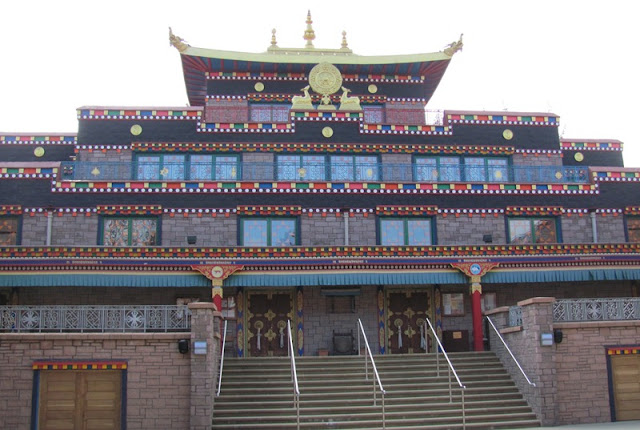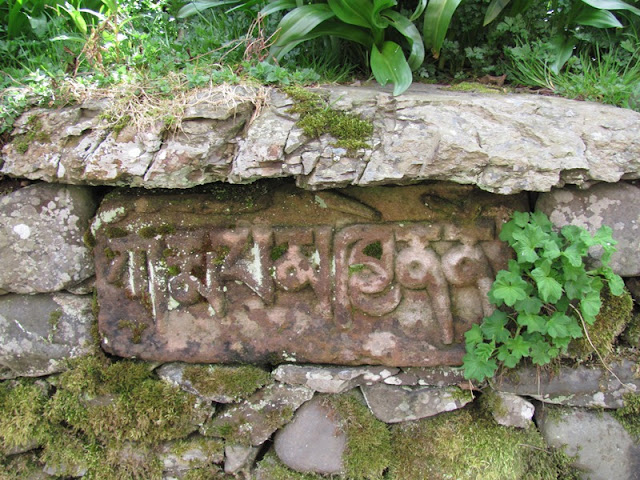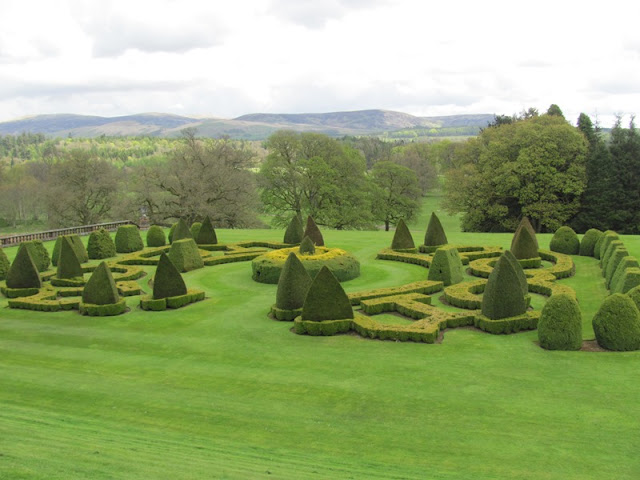The Duke of Buccleuch and Queensbury is one of the countries biggest land owners in the country (in acres that is - I'm sure in person he's quite small enough to pop into M&S and pick up something of the peg). He's beaten only by organisations, from largest to not quite so large, the Forestry commision, The National Trust, the Ministry of Defence, Pension Funds (if you get to gather them all together), Utilities (collected water, railways, electricity etc.)(and to think only £150 in Monopoly), The Crown Estate (does that mean the Queen or something a little different do you think??) and the RSPB (Hurray for birds). The Duke of Westminster has more than 100000 acres less but he's got a great lump of his in London rather than rural Dumfriesshire so he's six times richer in value of land.
The Dukes of Buccleuch and Queensbury trace their ancestry back to
James Douglas, or the Black Douglas, who was Robert the Bruce's chum. It's always good to pick the winning team and through the 14th century the Douglas family became one of the most powerful in Scotland. It is in 1388 that a Douglas is first recorded owning the land in the area of Drumlanrig. Because they became so powerful, in the following century the Douglas family started to fall out of favour with the royal family and it wasn't until the
union of the crowns that the family found them self back on completely solid ground again. It was in the reign of Charles II that Sir William Douglas became the 1st Duke of Queensbury and it was he that built the rather magnificent house we see below, known as
Drumlanrig castle between 1679 and 1691.
On the death of the 4th Duke of Queensbury (who enjoyed everything in life that his mother told him not to), the title passed on to the great grandson of the 2nd duke, who as it happened was also the 3rd duke of Buccleuch, which is where the titles were joined up. A few hundred years later, the current Duke (10th of Buccleuch and 12 of Queensbury) has added quite a host of other titles to the collection.
The castle as we see it today is very similar to the original of the 17th century though the curved stairs you see at the front here are a later addition - there was just one straight staircase when it was built.
The duke has one of the finest collection of paintings in private hands in the world and many of them are in the castle. As in most stately homes, photography isn't allowed in the house but I've managed to round up some pictures of a few of the more interesting paintings that I saw.
This painting is of
Francis I of France, painted in around 1530 by what is described as "circle of
Joos Van Cleve". For all it is 500 years old and shows some of the painting peculiarities of the time there seems something quite fresh about the painting. A little more about Francis later.
This tapestry is said to have been done by
Mary Queen of Scots and her ladies in waiting while imprisoned in England. I'm not sure she'd be pleased with it hanging here in the castle as she once referred to "Drumlanrig young and old" as "hellhounds, bloody tyrants, without souls or fear of God" for their part in deposing her in 1567.
A little further along the tapestry she has a go at Elizabeth I of England by portraying her with a beard and masculine clothing.
Of the more famous artists features in collection is this painting by
Hans Holbein the younger (though it is listed as workshop or follower in places) of Sir Nicolas Carew.
There might be some debate over the Holbein but nobody is suggesting that the
Rembrandt isn't the real deal. It's a Portrait of and Old Woman reading from 1655.
Once the Duke's most famous painting and now probably his most infamous after it's theft in 2003. It is
Leonardo da Vinci's Madona of the Yardwinder. It turned up again in 2007 and is currently not at Drumlanrig but at the National Gallery of Scotland in Edinburgh, but since I've seen it there, it seems quite reasonable to give it a mention.
What would a da Vinci be without a bit of mystery - there are two versions, probably both with a large input from Leonardo as far as I can make out - and 40 copies by pupils or followers. Wikipedia has a page
devoted to it here which you can read for yourself.
Briefly to return to Francis I of France - he knew Leonardo and persuaded him to move to France into his service (he took the Mona Lisa with him). Francis probably knew the painting well as it was his father in law, the previous king, Louis XII, who owned the painting. His portrait would have seen the 2003 theft as it was hanging on the same wall.
This portrait by
Philip de Laszlo is of Mary, countess of Dalkeith, wife of the future 8th Duke of Buccleuch in 1932. The Earl of Dalkeith is the title held by the next in line to the Dukedom.
This is probably my favourite painting in the castle. It's of Jane, Countess of Dalkeith (future 9th duke's wife this time) from 1957 by
John Merton. Before she was married she was a fashion model for
Norman Hartnell.
Here she is again on the cover of Life in 1953.
There is a what looks like a walled garden entrance but no walled garden behind it. Just a few acres of manicured lawn and topiary hedges. running into woodland and the distant scenery.
Had I read the guide book before I left (rather than later when tucked up with my cocoa) or if the weather had been a bit more conducive to a longer walk round the grounds then I would probably have found the Andy Goldworthy
striding arch that has been built in a stream in the woods below the castle.
This blogger found it in weather worse than I had.
A view of the castle from the back - it's a square old thing.
A cup of Earl Grey in the cafe. Look at that! most places give you a little biscuit with your tea, here you get a bit of tablet - very nice too.
A last look back from the drive as I was leaving.




























































